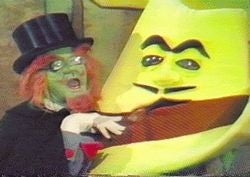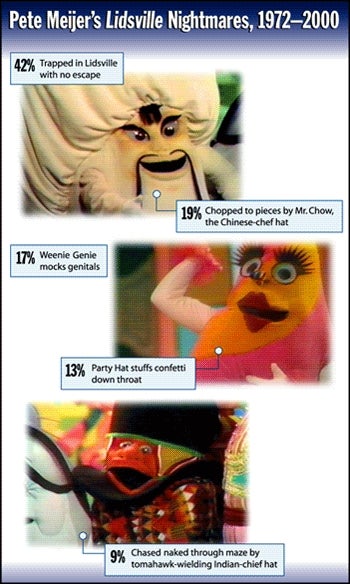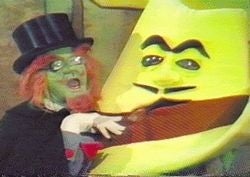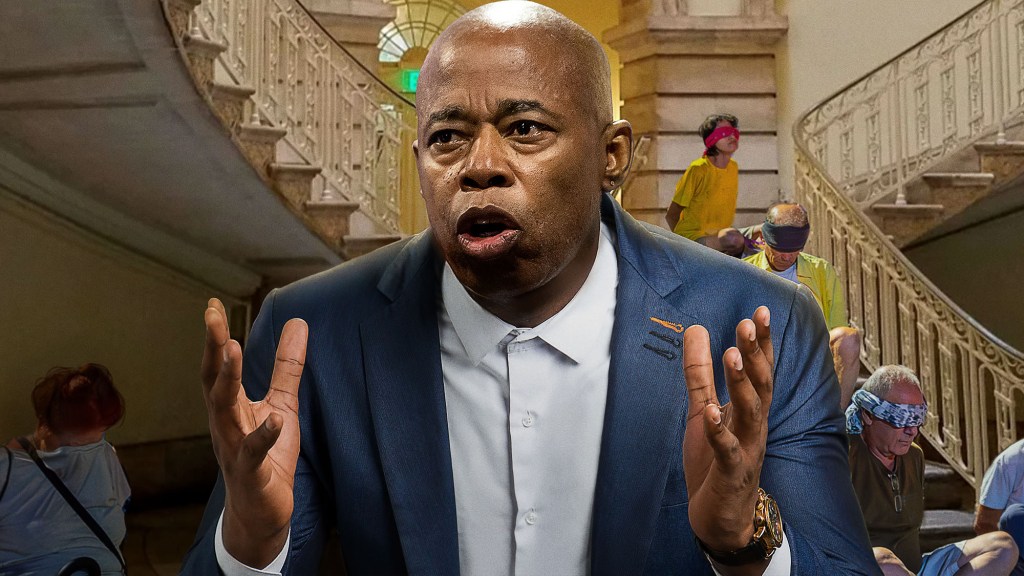BOWLING GREEN, KY–Though their frequency has decreased since childhood, 36-year-old graphic designer Pete Meijer still suffers from occasional nightmares related to Lidsville, the early-’70s Sid and Marty Krofft-produced Saturday-morning program featuring Charles Nelson Reilly cavorting with a frightening assemblage of sentient headgear.

“It happened again last night,” Meijer said. “I dreamed I was driving to work, in my father’s car for some reason, and the sky started getting darker and darker. Then, from out of nowhere, the giant cowboy hat that talked like John Wayne jumped in front of my windshield and started peering into the car with a look of murderous hate.”
“That was when I woke up with a jolt,” Meijer continued. “I never got back to sleep.”

In the program, a boy named Mark becomes trapped in a nightmarish, Technicolor parallel universe populated by anthropomorphic talking hats. The central villain is Hoo-Doo, an evil magician played by Reilly in horrifying makeup and facial prosthetics. Poor puppetry and cheap special effects contributed to the show’s queasy, disorienting feel, as did the presence of dwarf actors inside the hat costumes.
Though still haunted by images from the program, Meijer has made great progress since childhood.
“From about 1972 to 1978, I had Lidsville nightmares pretty much every night,” Meijer said. “In one of the more frequent ones, I’d go downstairs for breakfast, but my mother wouldn’t be in the kitchen. Instead, that cone-shaped party hat with the giggly voice would be there, as though she had replaced my mother. I also had a lot of dreams where the football helmet locks me in a cage and pushes it into the ocean. And, needless to say, I often dreamed I was falling into the giant hat in the opening credits.”

Eventually, through therapy and medication, Meijer was able to largely control the traumatizing effects of the program. But the nightmares return from time to time.
“I still have one or two a year,” Meijer said. “A few months ago, I dreamed that Hoo-Doo was chasing me around, trying to tie me down and give me an enema. Still, I’m much better than before. Almost normal.”
“You know,” he added, “there were supposedly good hats and evil hats on the show, but in my dreams they’re all equally disturbing.”
Plaguing Meijer perhaps worst of all is the character “Weenie Genie,” a boy genie inexplicably played by middle-aged actress Billie Burke–the woman who played Witchiepoo in the equally traumatic Krofft series H.R. Pufnstuf–wearing ghoulish makeup.
“I’d definitely say Weenie Genie is in my nightmares more than any of the others,” Meijer said. “Weenie’s supposed to be a boy, but he’s played by someone who’s obviously a woman. I think seeing that as an 8-year-old boy seriously damaged my still-developing sense of gender identity.”
According to psychologist Dr. Deborah Kreutz, Meijer is far from alone in his fear of Lidsville.
“To this day, the scars of Lidsville run deep through American society,” Kreutz said. “Remember, approximately 40 million Americans were exposed to this show as children, so we’re talking about a mass, televised trauma whose psychological ramifications continue to weigh heavily on our collective national psyche.”
In 1999, a team of UCLA psychologists compiled a ranking of lingering childhood traumas among Americans between the ages of 30 and 40. Lidsville ranked second overall, just ahead of the Child Catcher from Chitty Chitty Bang Bang and Sigmund & The Sea Monsters, another Krofft program. Ranked first were the Oompa-Loompas from Willy Wonka & The Chocolate Factory.







